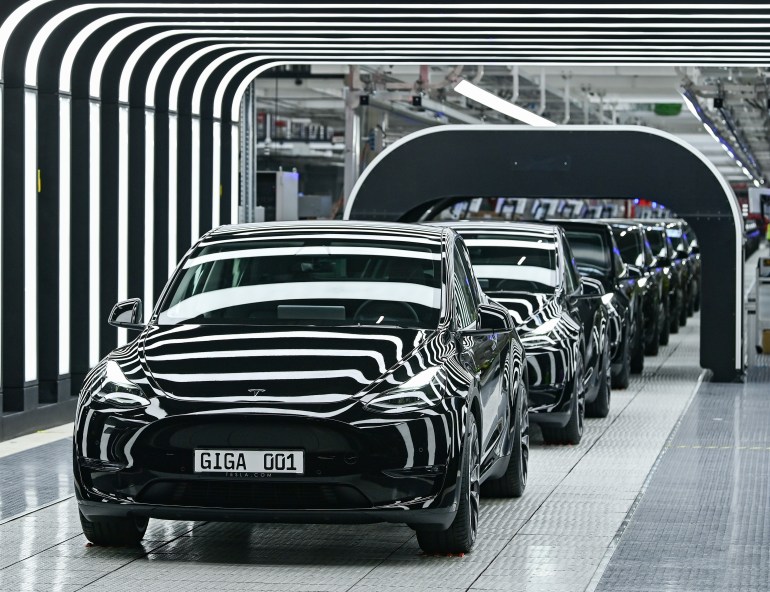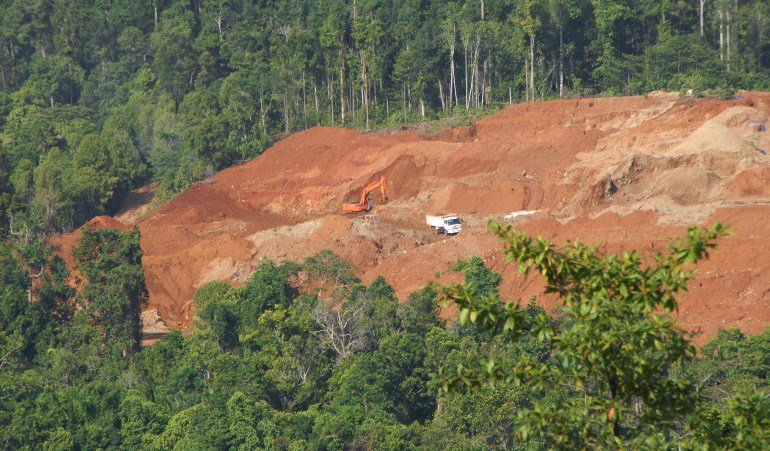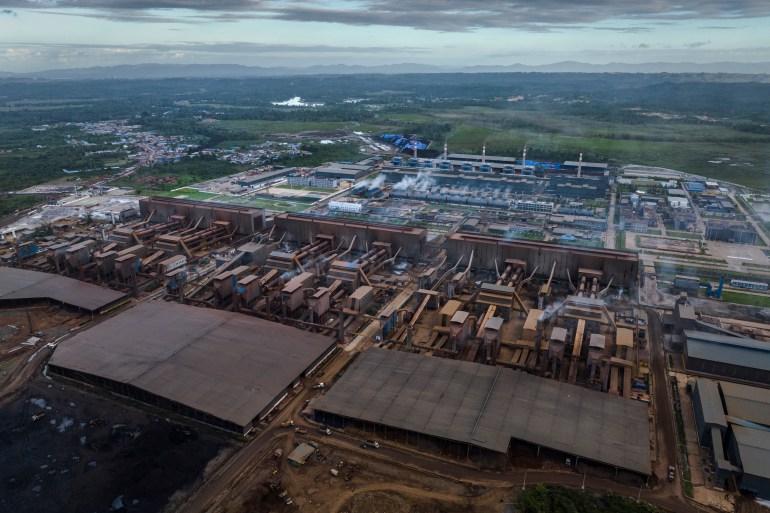As the push to switch away from polluting fossil fuels and go green with renewable technology becomes more pressing around the world, the popularity of electric vehicles (EVs) has surged. But now, rights groups say that the growth of this industry is wreaking environmental havoc of its own as well as harming local communities in Indonesia, the Philippines and the Democratic Republic of the Congo (DRC).
Demand for EVs was initially slow but orders have tripled in the past few years, with electric cars accounting for 14 percent of total car sales in 2022, up from just 4 percent in 2020, thanks to heightened environmental awareness and a wider choice of cars on offer to consumers.
The transport sector has long been a target for green activists as it contributes to one-sixth of global carbon emissions. But while sleek, battery-powered vehicles produced by companies like Tesla and Ford are being held up as a shining solution to this issue, the EV industry is harbouring a dark side of its own.
Reports from several rights groups in recent months have revealed how the increase in mining of crucial materials like nickel – the silvery-white metal used to manufacture EV batteries – is harming several communities and, ironically, causing environmental damage across Indonesia and the Philippines, which are home to the largest nickel deposits in the world.
Mining watchdogs have also sounded the alarm about damage caused by the mining of cobalt and coltan – also important for EVs – in the DRC.

How are communities being harmed?
Residents living near nickel mining sites on the island of Halmahera in the northern Maluku province of Indonesia say they are being coerced and intimidated by mining companies operating in the Indonesia Weda Bay Industrial Park (IWIP), according to recent findings by Climate Rights International (CRI). The area, one of the largest nickel production sites in the world, is home to nickel mines and nickel-smelting plants which supply international EV manufacturers.
In a 124-page report released in January, CRI alleged that companies mining in IWIP often collude with the police to force landowners in nearby villages such as Gemaf, Lelilef Sawai and Lelilef Waibulan to sell their land or even to leave without any compensation at all. In some cases, community members, many of them farmers, say they have arrived on their land only to see tractors digging it up without their consent.
Some farmers who have contested unfair prices, protested land grabbing or outright refused to sell have reportedly received threats from the police and military. Since the construction of the park started in 2018, security officials have swarmed the area, residents say.
Large swaths of forests are also being cleared for mining in the region, the rights group found. CRI estimates that about 5,331 hectares (13,173 acres) of forest have been taken over for mining activities. Since trees store carbon, removing them means more emissions.
Last year, another rights organisation, Survival International, warned that about 300 to 500 groups of O Hongana Manyawa, or “People of the Forest”, in the area of the IWIP may be at risk of losing their homes if the ongoing deforestation continues.
Working conditions are poor, residents say. In December last year, an explosion at the Chinese-funded Morowali Industrial Park on Sulawesi Island killed 12 people and injured at least 39 others.
Besides that, polluted water is being channelled from the park into the river from which local people source drinking water. The resulting oily substance on its surface is now forcing fishermen from the nearby Sagea village to row further out to sea.
Furthermore, to power the enormous park, five polluting coal-fired plants, producing 3.78 gigawatts annually, have been installed, according to CRI. Members of local communities say the smoke from the plants is choking the air and causing breathing difficulties.

Why is nickel so important?
For decades, nickel was primarily used to produce stainless steel because of its durability and malleable nature. In more recent times, it has been used for the manufacture of car components such as wheels and bumpers.
But demand for the metal has skyrocketed since the push for renewable technologies, including EVs, has taken hold. The material forms the basis for lithium-ion batteries, which are used in electric vehicles. Demand for nickel grew by 41 percent between 2010 and 2020, according to the Nickel Institute, the global association of nickel producers.
Indonesia is positioning itself strategically for an EV-driven world. The country produced the highest amount of nickel in 202, contributing 48 percent of global supply, and outgoing President Joko Widodo’s administration has enforced policies banning nickel ore exports, essentially ensuring that nickel processors establish plants in the country.
Several large mining companies are pouring money into the sector. The IWIP, constructed between 2018 and 2020, is one of several nickel processing parks being developed across Indonesia. The park is a joint venture between Chinese companies Tsingshan Group, which has a 40 percent shareholding through its subsidiary Perlus Technology, Huayou Group (30 percent) and Zhenshi Group (30 percent).
French mining company Eramet has also partnered with Tsinghan and the Indonesian steel company, PT Antam Tbk, to manage the Weda Bay Nickel mine, which supplies nickel ore to smelting plants in the IWIP.
Separately, Eramet and Germany’s BASF have plans for a nickel and cobalt refining facility which is projected to produce 67,000 tonnes of nickel and 7,500 tonnes of cobalt annually in the IWIP.
Tesla sources nickel from Huayou and CNGR Advanced Materials, which partners with Tsinghan and which has been implicated in environmental pollution in Maluku as well as in the Central Sulawesi province, according to the Business and Human Rights Resource Centre. Ford and Volkswagen also source nickel from companies mining within the IWIP, CRI found.

Which other countries are affected?
Concerns about mining practices have been raised for some time in the Philippines, which is the second-largest producer of the metal and the leading supplier to China.
In 2021, Amnesty International reported that scores of people working on nickel mining projects on the Dinagat Islands were being hired without contracts and health insurance, despite the risky nature of their jobs and in violation of Philippine labour laws.
Companies mining in the area are mainly Chinese and Philippine and include Sinosteel (Chinese state-owned), Cagdianao Mining Corporation (Philippine), Oriental Vision Mining (Philippine and Chinese), Libjo Mining (Philippine and Chinese) and Century Peak Corporation (Philippine).
In the DRC, the mining of cobalt and coltan, which are also important components in rechargeable batteries, has forcefully displaced communities in mineral-rich areas such as Kolwezi in the southern Lualaba province, Amnesty International and the Good Governance and Human Rights Initiative (IBGDH) found in 2023.
The DRC has the world’s largest reserves of cobalt and is the seventh-biggest producer of copper, but those have not served the Congolese people much. The country’s economy is stagnant because of decades of conflict and poor governance. Primarily Chinese companies, in partnership with state mining corporations, are extracting minerals there.
Like nickel, global demand for cobalt and copper has also risen since mobile phones and other smart electronic gadgets like video game consoles became popular. A mobile phone battery typically contains about 7g (0.25oz) of cobalt and 16g (0.56oz) of copper. A fully electric bus contains 400kg (882lb) of copper.
What action is being taken to counter these issues?
There has been little official action.
In Indonesia, several advocacy groups have been protesting and lobbying against the vast IWIP mining project, but mining and refining processes are unlikely to be stopped there.
In its report, the CRI recommends that the government intervene and order all companies to cease intimidation tactics, as well as strengthen laws protecting local communities from the consequences of mining. The group also wants the main companies involved in IWIP to clean up polluted water sources, compensate local people for stolen land and switch to renewable energy.
As for the DRC, a 2009 initiative was set up by the International Tin Association and the Tantalum-Niobium International Study Center to help big buyers like Apple, Intel and Tesla trace and verify their supply chains. However, a 2022 investigation by investigations and advocacy group Global Witness found that despite this intervention, conflict minerals and those sourced from mines using child labour were still entering global supply chains.
Although Tesla was indirectly implicated in that report, the automaker comes third in a ranking of EV manufacturers based on responsible sourcing and fossil use. Ford and Mercedes-Benz top the list, while Toyota, Honda and GAC are at the bottom.
In the past, the 2010 US Dodd-Frank Act contributed majorly to reducing the supply of minerals sourced in the DRC’s conflict zones – so-called “blood diamonds” – by forcing companies to detail their supply chains.

